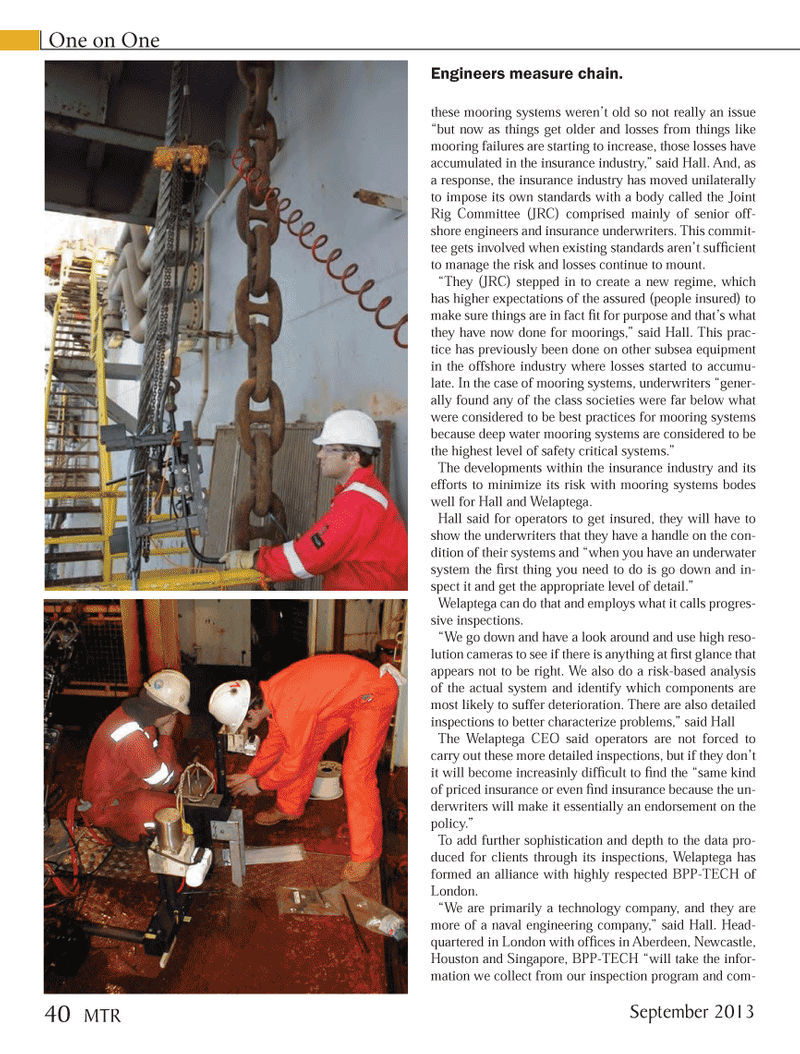
Page 40: of Marine Technology Magazine (September 2013)
Ocean Observation: Gliders, Buoys & Sub-Surface monitoring Networks
Read this page in Pdf, Flash or Html5 edition of September 2013 Marine Technology Magazine
these mooring systems weren?t old so not really an issue ?but now as things get older and losses from things like mooring failures are starting to increase, those losses have accumulated in the insurance industry,? said Hall. And, as a response, the insurance industry has moved unilaterally to impose its own standards with a body called the Joint Rig Committee (JRC) comprised mainly of senior off- shore engineers and insurance underwriters. This commit- tee gets involved when existing standards aren?t suf cient to manage the risk and losses continue to mount.?They (JRC) stepped in to create a new regime, which has higher expectations of the assured (people insured) to make sure things are in fact t for purpose and that?s what they have now done for moorings,? said Hall. This prac- tice has previously been done on other subsea equipment in the offshore industry where losses started to accumu- late. In the case of mooring systems, underwriters ?gener- ally found any of the class societies were far below what were considered to be best practices for mooring systems because deep water mooring systems are considered to be the highest level of safety critical systems.? The developments within the insurance industry and its efforts to minimize its risk with mooring systems bodes well for Hall and Welaptega. Hall said for operators to get insured, they will have to show the underwriters that they have a handle on the con- dition of their systems and ?when you have an underwater system the rst thing you need to do is go down and in- spect it and get the appropriate level of detail.? Welaptega can do that and employs what it calls progres- sive inspections. ?We go down and have a look around and use high reso- lution cameras to see if there is anything at rst glance that appears not to be right. We also do a risk-based analysis of the actual system and identify which components are most likely to suffer deterioration. There are also detailed inspections to better characterize problems,? said Hall The Welaptega CEO said operators are not forced to carry out these more detailed inspections, but if they don?t it will become increasinly dif cult to nd the ?same kind of priced insurance or even nd insurance because the un- derwriters will make it essentially an endorsement on the policy.? To add further sophistication and depth to the data pro- duced for clients through its inspections, Welaptega has formed an alliance with highly respected BPP-TECH of London.?We are primarily a technology company, and they are more of a naval engineering company,? said Hall. Head- quartered in London with of ces in Aberdeen, Newcastle, Houston and Singapore, BPP-TECH ?will take the infor- mation we collect from our inspection program and com-One on One Engineers measure chain. September 201340 MTRMTR #7 (34-49).indd 40MTR #7 (34-49).indd 408/26/2013 11:27:41 AM8/26/2013 11:27:41 AM

 39
39

 41
41
